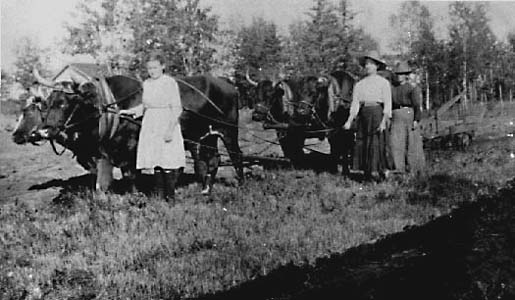Search | Image Archive | Reference | Communities | POV | Lesson Plans | Credits
 One of the challenges facing early prairie farmers was to guarantee adequate soil moisture. Those who attempted to farm the semi-arid dry-belt in the southwest of the province soon discovered that the techniques practised in the Red River Valley and in Southern Ontario were unsuitable. They discovered that unless stringent water conservation techniques were employed, crops would almost certainly fail in the second year a field was put under cultivation.
One of the challenges facing early prairie farmers was to guarantee adequate soil moisture. Those who attempted to farm the semi-arid dry-belt in the southwest of the province soon discovered that the techniques practised in the Red River Valley and in Southern Ontario were unsuitable. They discovered that unless stringent water conservation techniques were employed, crops would almost certainly fail in the second year a field was put under cultivation.
Summer fallowing was first practised not as a means of water conservation, but rather as a means of weed control. By ploughing or discing a fallow field in late fall or early spring, weed seeds in the soil would be exposed to the sun, germinate early, and be killed by frost. The immature weeds could then be cut into the soil by a second round of discing where they would enrich the soil. Any remaining weeds could be ploughed under before the seeds matured.
By the 1890s, farmers began to realize that fallowing could also be used as a method of soil moisture conservation. Gradually techniques were developed to ensure that as much water as possible remained in the soil. The primary tool used in this method was the disc cultivator, a frame of metal wheels or discs that was dragged behind a horse team or tractor.
Discing was done many times over the fallow season. First it was done to pulverize the lumps of soil to improve the capillarity, or water absorbing ability of the soil. Later in the spring, the field was disced again to kill any weeds before they used up too much soil moisture. In the fall, the fields were disced again, this time to bring any weed seeds to the surface where they would germinate to be killed by the fall frosts and form a moisture-retaining mulch on the surface. Finally, before the snow fell, the field would be cultivated again so as to form a series of small ridges to limit runoff and capture meltwater, preserving the maximum amount of snow moisture.
By the 1920s, years of experimentation by independent farmers and by researchers at institutions like the Manitoba Agricultural College and the Dominion Experimental Farm had established routines of crop rotation and fallowing that made dryland farming more productive and much less prone to failure.
Page revised: 27 August 2009